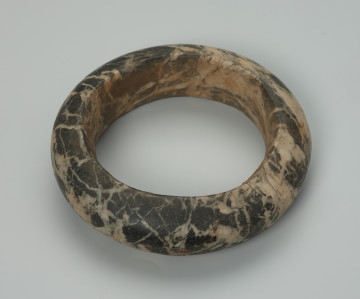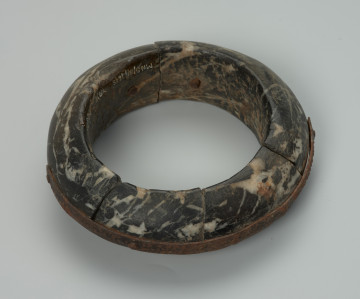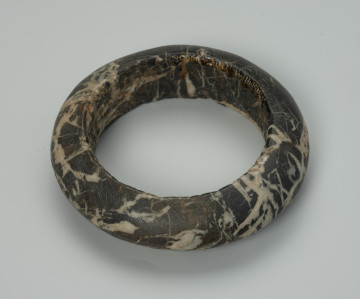
Men's bracelet
między 1930 — 1940
National Museum in Szczecin
Part of the collection: Collection of Dogonian art
The presented specimen is a rare example of a necklace worn by older men. It is decorated with kauri shells, which may have been added later to make it more attractive and easier to sell. The function of the necklace has not been identified, but judging by the care taken in its manufacture, it played a vital role in the Dogon life. In the patriarchal society of the Dogon it is the man who plays the dominant role. Depending on his age, he belongs to one of four groups. The first is disciples, which includes young men aged 12-20, called unrunw soro, meaning children who are developing, aged 21-28 - saga tara unrunw - planted children and aged 28-36 - anrunw poju, meaning excellent men. In the second group, called teachers, we find those between the ages of 36-44 - inew na - great men and 44-52 - ine naginru du dan, meaning those responsible for the family. The next group is the guides. It consists of mature men aged 52-60 called inew nayun puyopuya wo-in - those who own the flower of death, and 60-68-year-old ginna benw - owners of great families. The last and most important group includes older men aged 68 and over, called ogo-unw - patriarchs. The fourth group was called ancestors. The necklace may have been worn by men from the group of guides, who are nowadays counted as one of the most important groups. These men are referred to as sages. Their task is to create rules for the good functioning of the community. They are obliged to teach and set an example in everyday life. When these men reach the age of 60, they enter the group of ancestors. According to Dogon beliefs, a man older than 60 years, even if he is still alive, is considered dead and belongs to the world of the dead ancestors - those whose souls are respected and venerated.
Katarzyna Findlik-Gawron
Author / creator
Dimensions
cały obiekt: height: 27,8 cm
Object type
body adornment
Creation time / dating
Creation / finding place
Identification number
Location / status

między 1930 — 1940
National Museum in Szczecin

między 1930 — 1940
National Museum in Szczecin

między 1930 — 1940
National Museum in Szczecin
DISCOVER this TOPIC
Museum of King Jan III's Palace at Wilanów
DISCOVER this PATH
Educational path